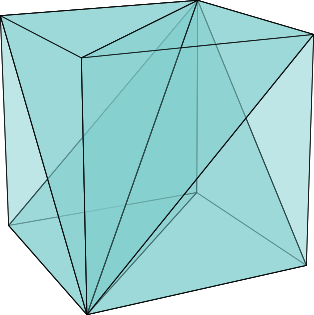First using a three dimensional unit cube as an example for the term "regularity", we can have two possible triangulations:
(A)
(B)
We say the lower triangulation is more "regular" than upper triangulation in that the following ratio for each simplex $K$ varies less among all the simplices: $$ \alpha_K = \frac{\rho_K}{r_K}, \tag{1} $$ where $\rho_K$ is the radius of the inscribed sphere for a simplex $K$, and $r_K$ is the radius of the circumscribed sphere.
If a triangulation is more regular than another, then after a local refinement using "irregular cuts", say, longest edge bisection for each simplex for both triangulations, we are more likely to get an equal regular triangulation for a more regular triangulation (like B) than a less regular triangulation (like A).
A "regular cut" is something like octasection of a tetrahedron by connecting the midpoints of each edge to get $2^3$ similar tetrahedra, just smaller. An "irregular cut" is like following:

in that a simplex is only being divided into 2 smaller simplices. The following figure shows the result of bisecting using the longest edges for all tetrahedra for B(left) and A(right):

For the longest edges varies for triangulation A, to keep the subdivision as a triangulation (no hanging vertices), we need to subdivide more. Needless to say which one is more regular.
When going into four dimensions, things get quite nasty. I am developing an automated mesh generation library for 4-manifold (say we already know that this manifold has piecewise linear structure, and is triangulable), I found that I simply can not afford "regular cut" for the triangulation. I will get $2^4$ smaller 4-simplices from just one 4-simplex, and the computer runs out of memory pretty fast during refining. Hence I could only afford local refinement using "irregular cuts".
For 4D triangulation, if using Whitney's trick, then 4-manifolds is divided into hypercubical lattices, then each cube is triangulated into 4-simplices. I wanna avoid to get the triangulation like (A) but rather to have triangulation like (B).
Finally my question is: how to triangulate a hypercube resembling (B)? in the sense that, after bisecting the longest edge for a 4-simplex (and its neighboring simplices), the regularity of the mesh does not change too much in terms of the ratio in (1).
Any reference is welcome too.
